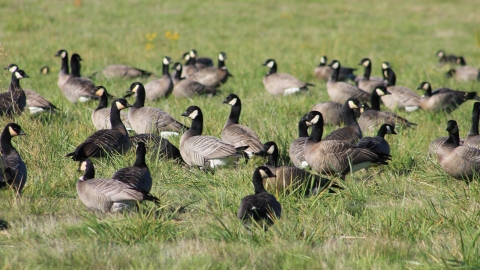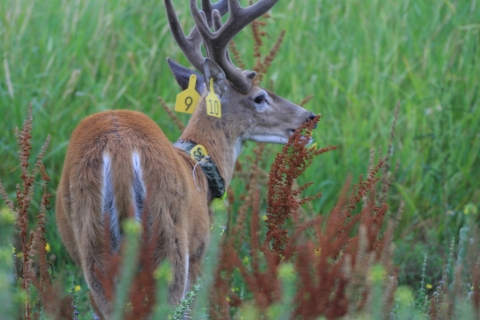Sometimes a fire can be just what nature’s doctor ordered. At Ridgefield National Wildlife Refuge, fields that were once used for agriculture are being prepared for new life as native wetland prairie habitat for dusky Canada geese, foraging migratory waterfowl, and grassland-dependent wildlife.
Fire has been used by the Service since the 1930s to help manage lands, improve ecological conditions, and lower the risk of catastrophic fire. This long-term, balanced approach to fire management benefits both people and wildlife.
“Prescribed fires can be an incredibly useful tool to reach the habitat conditions ideal for wintering waterfowl. Fire is and has always been a natural part of this ecosystem. Because of this, the land responds to fire differently than when using mechanical or chemical treatments,” said Juliette Fernandez, Project Leader for the Ridgefield National Wildlife Refuge Complex. “It clears away old compacted vegetation and deposits rich nutrients in the soil. It provides native plants the opportunity to outcompete invasive plants that don't tolerate fire as well and we see the native plants flourish, expand and support the wintering birds that rely on us for food and rest.”
At Ridgefield, prescribed fire was first used in 2018 and is part of a longer term plan to help restore native plants, grasses, and trees. Additionally, the five former pasture lands include invasive plants like reed canary grass that prevent native plants and those that wildlife like to eat from growing. As each of the five units is treated, restoration can take place – improving habitat and increasing the amount of food available for wildlife.
An important management tool, prescribed fire planning always puts safety first. Often, the U.S. Fish and Wildlife Service will work with partners like the U.S. Forest Service or Washington Department of Fish and Wildlife.
“Our community is very important to us. We will do everything possible to ensure limited disturbance while reaching our invasive species invasive species
An invasive species is any plant or animal that has spread or been introduced into a new area where they are, or could, cause harm to the environment, economy, or human, animal, or plant health. Their unwelcome presence can destroy ecosystems and cost millions of dollars.
Learn more about invasive species removal and habitat enrichment goals. In addition to posting on our website and social media sites, we will post on-site when we will be burning,” said Fernandez.
The refuge is largely separated from the public by waterways or fire breaks (areas of bare ground to prevent the fire from spreading), but smoke may be visible when prescribed burns are taking place.
Surrounded by the community of Ridgefield and 14 miles from the fourth largest city in the State of Washington, Vancouver, the refuge provides an oasis for fish, wildlife, and plants to call home. Established in 1965 to provide habitat for dusky Canada geese, the refuge also protects state and federally protected species such as Columbian white-tailed deer and other wildlife. Over 200 species of birds, 35,000 wintering geese, 3000 swans, and 4000 Sandhill cranes rely on the refuge. Trails, an auto-tour route, and active hunt program – it’s a place where people of all abilities can enjoy nature and their outdoor traditions.
September 2022 Prescribed Fire Plans
During the month of September, if conditions are favorable, Ridgefield National Wildlife Refuge will be conducting prescribed burns on Bachelor Island within the refuge. The sites being treated are upland grassland and seasonally flooded wetland swales that are overgrown with invasive reed canarygrass. By using fire to burn away the invasive grass, new growth will encourage native plants that geese, dabbling ducks, and Columbian white-tailed deer prefer.
U.S. Fish and Wildlife Service fire fighters will be on hand to manage the prescribed fire and keep it within the confines of the prescribed burn prescribed burn
A prescribed burn is the controlled use of fire to restore wildlife habitat, reduce wildfire risk, or achieve other habitat management goals. We have been using prescribed burn techniques to improve species habitat since the 1930s.
Learn more about prescribed burn areas. Afterwards, they will be on hand to mop up and patrol. There are five units of land within the refuge that will be treated – a total of 95 acres.
Members of the public may see smoke columns from the Refuge when the burn is taking place.
If you have questions about the prescribed fire program please contact the refuge office at 360-887-4106.







